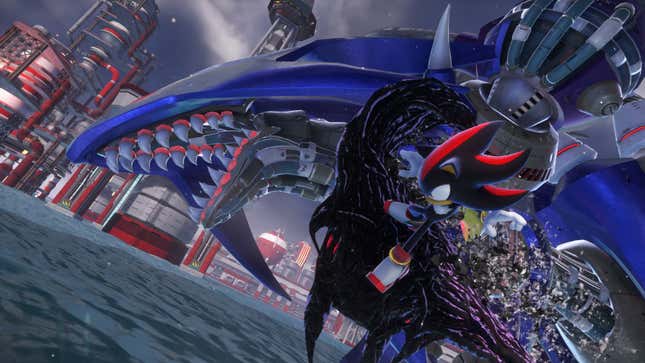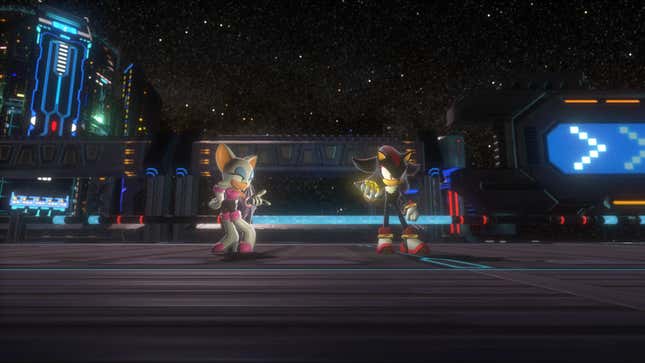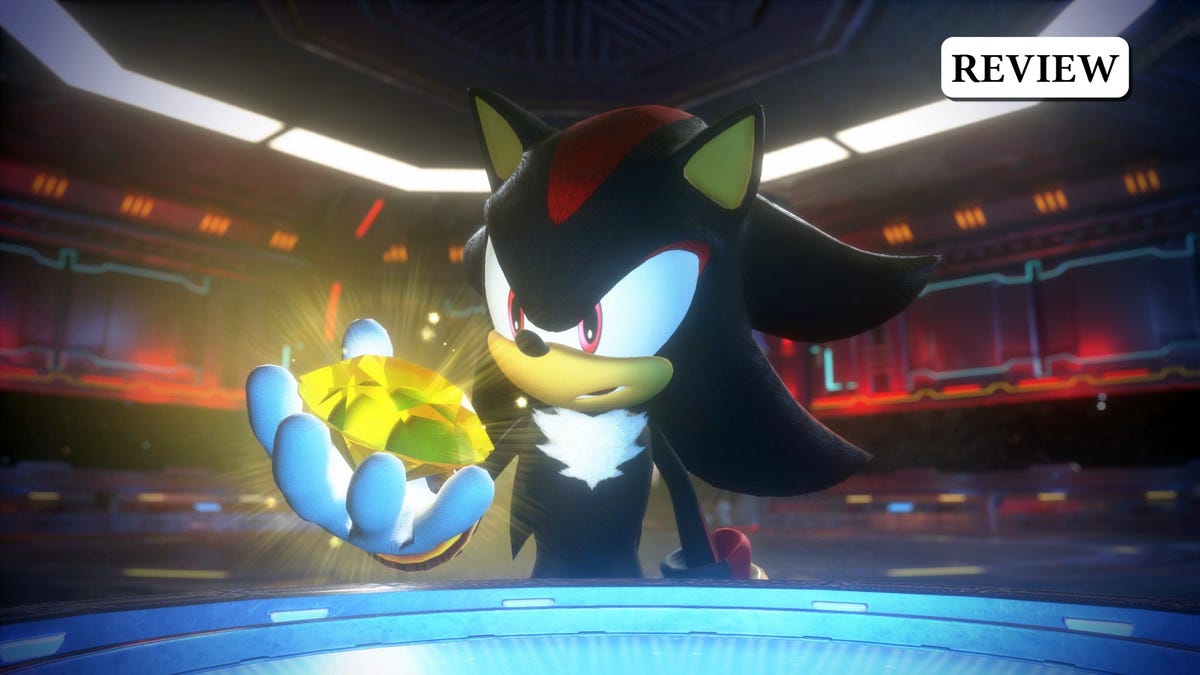People will no doubt call Sonic X Shadow Generations a “love letter” or “tribute” to Shadow the Hedgehog, Sonic’s brooding rival who debuted back in 2001’s Sonic Adventure 2. But as a person who grew up seeing the black-and-red hedgehog as the emotional center of the franchise, it feels more like an apology. Sega has not been kind to Shadow over the years. Where once he was a complex, playable mainstay in the series, the Ultimate Lifeform has become a flanderized background character defined almost entirely by not liking other people and wanting to beat the blue blur in any competition that will have him. Shadow Generations, a hefty pack-in alongside a full remaster of 2011’s Sonic Generations, delivers a wonderful course-correction for Sega’s mistreatment of Shadow over the years, reminding fans that he was once the deepest well of emotional storytelling the series has to draw from. The best part is that it’s also a thrill to play, feeling better than maybe any Sonic game has in, well, generations. That’s right, Sega is releasing one of the best Sonic games it’s ever made as a pack-in for a remaster.
Shadow Generations takes place alongside the original Generations and shows what Shadow was up to while Sonic was living his past lives. Sonic Generations, originally released in 2011, had the speedster running around remade versions of old levels that were re-tuned for both the 2D sidescrolling approach of the older games and the 3D platforming action of the modern era. Shadow Generations takes the same idea but applies it to Shadow, and given that he’s got a much more tragic past than Sonic, revisiting previous levels and games means retreading some old wounds once thought healed, while cleverly working his journey into Sonic Generations’ 13-year-old story. However, Shadow has been sidelined for so long that there aren’t as many levels to draw from. So Shadow Generations breaks the old rules in which characters revisit their own past, instead pulling some levels from future games like Sonic Forces and Sonic Frontiers (which Shadow was notably absent from), but even if it has to contort around its premise, it pays off because Shadow Generations is probably the tightest, most rewarding Sonic game in recent memory.
As I skated through Shadow’s past, I was constantly surprised at how Sega modernized decades-old levels into something new and thrilling, blending the fast-paced running and jumping fans that have come to expect with plenty of action-oriented setpieces that kept levels I had run through hundreds of times while growing up fresh. Despite his speed, Shadow controls with a precision that makes every level feel like a tight roller coaster ride, with different pathways to explore, collectibles to find, and stunts to pull as you barrel toward a goal ring or fight an old nemesis.

With a relatively short campaign of six stages with two levels each, Shadow Generations is able to meaningfully riff on old ideas and bring in new ones, all without overstaying its welcome. Shadow’s past comes back to haunt him in the form of lost friends and enemies, including his alien creator Black Doom from Shadow’s self-titled game. Interacting with the extraterrestrial race known as the Black Arms once again gives Shadow a chance to explore his own inner alien, gaining new abilities that fundamentally change how he moves through what could otherwise be a mundane Sonic level.
Shadow can now transform into a squid-like creature that can move along corrupted terrain like a Splatoon character, or summon an alien that can surf atop water. Shadow even grows giant, sludge-like wings that can let you fly over gaps, or even whole chunks of difficult levels. The last of those is so transformative that Shadow Generations gives you two high score counters depending on whether you use them or not. Sometimes these abilities can be finicky, the aforementioned squid transformation especially, but they’re meaningfully woven into old levels to shake them up, while also giving you tools to run around the game’s White Space hub world. Sonic Generations uses this void-like world in the form of a mostly uninvolving sidescroller between different levels. Conversely, Shadow Generations has a reasonably sized open-zone area that you can freely move around hunting for collectibles, meeting up with old friends, and reaching new levels.
If the stages themselves weren’t enough to make me appreciate how good Shadow Generations felt to play, the White Space’s open world solidified for me that Sega cooked with traversal this time around. The zone is covered in rings to collect, bumpers to send you flying across the world, and collectible art, background music, and lore drops all tied to Shadow’s history. In other words, Shadow Generations is practically a museum for its antihero. Though I spent only around four hours playing through its story, I spent over 20 hours running around the White Space and playing through remixed challenge levels to fill out the archive of Shadow’s life. I would not have done that if Shadow Generations hadn’t nailed its movement, offered interesting challenges, and made the most of its open world. As I searched for the final chests filled with concept art and songs (some of which I’ve listened to on repeat for the past 20 years), I lost sense of how much time I’d spent inspecting every nook and cranny because it was enjoyable just to run around, grind on rails, andr fly over the world trying to complete my collection.
If there’s a downside to just how good it feels to play Shadow Generations, it’s that the direct comparison with Sonic Generations is deeply, deeply unflattering for the earlier game. A lot has happened since the original was released, and more recent entries like Forces and Frontiers have fine-tuned Sonic’s speed and control to reach what Shadow Generations pulls off. As a result, Sonic Generations doesn’t hold up as well and feels frozen in time. Sonic moves a little awkwardly, the steering feels less exact, and some of the remixed levels don’t feel as intentional. It’s still a fun tribute to the blue guy’s past, but it feels like a new Generations game with all the modern trappings of Shadow’s would do him good.

As nice as it is to look back at old concept art, listen to Shadow’s edgy, dramatic butt rock themes from the early 2000s games, and experience levels I played on repeat as a kid, Shadow Generations feels bittersweet. When you look at the release dates of most of the games it draws from, you realize how many years we lost with Shadow as a centerpiece for the franchise in pursuit of something more streamlined and focused almost solely on Sonic. Sega has made a lot of mistakes with the franchise, like sanding away its AMV-bait edges in favor of a more brand-safe image, and Shadow was one of the biggest casualties of that pivot. Sega even made attempts to erase that past by delisting games from that era when they were critically panned.
My hope is that Sega going back and reflecting on what Shadow has lost in the past 20 years will make the company think about what it can reclaim. What better time to realize this than during the Year of Shadow, just as a new generation of Sonic fans is about to learn all about him when Sonic the Hedgehog 3 premieres in December? Sometimes brand synergy leads to a genuine celebration of something, and in the case of Shadow Generations, it’s long overdue.

